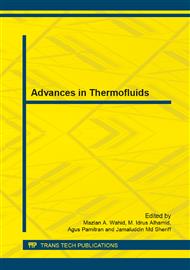[1]
Seyed Ehsan Hosseini, Mazlan Abdul Wahid, Feasibility study of biogas production and utilization as a source of renewable energy in Malaysia, Renewable and Sustainable Energy Review.
DOI: 10.1016/j.rser.2012.11.008
Google Scholar
[2]
Seyed Ehsan Hosseini, Mazlan Abdul Wahid, Abuelnuor Abdeen Ali Abuelnuor, High temperature air combustion: sustainable technology to low NOx formation, International Review of Mechanical Engineering, Vol. 6, N. 5, July (2012).
Google Scholar
[3]
Katsuki, M. and Hasegawa, T. (1998) The science and technology of combustion in highly preheated air. Proc. Combust. Institute, 27, 3135–3146.
DOI: 10.1016/s0082-0784(98)80176-8
Google Scholar
[4]
Kumar, S., Paul, R.J., and Mukunda, H.S. (2002) Studies on a new high-intensity low emission burner. Proc. Combust. Instit., 29, 1131.
DOI: 10.1016/s1540-7489(02)80143-2
Google Scholar
[5]
Cavaliere, A. and de Joannon, M. (2004) MILD combustion. Prog. Energy Combust. Sci., 30, 329.
Google Scholar
[6]
Plessing, T., Peters, N., and Wu¨nning, J.G. (1998) Laser optical investigation of highly preheated combustion with strong exhaust gas recirculation. Proc. Combust. Instit., 27, 3197.
DOI: 10.1016/s0082-0784(98)80183-5
Google Scholar
[7]
Kishimoto K, Watanabe Y, Kasahara M, Hasegawa T, Tanaka R. Observational study of chemiluminescencefrom flames with preheatedandlow oxygen air. The First Asia-Pacific Conference on Combustion, May 12–15, Osaka, Japan. 1997, p.468–71.
Google Scholar
[8]
Hasegawa T, Tanaka R, Niioka T. Combustion with high temperature low oxygen air in regenerative burners. The First Asia-Pacific Conference on Combustion, May 12–15, Osaka, Japan. 1997, p.290–3.
Google Scholar
[9]
Blasiak W, Szewczyk D, Dobski T. Influence of N2 addition on combustion of single jet of methane in highly preheatedair. Proceedings of IJPGC'01, June 4–7, New Orleans, USA, FACT-19048. ASME; (2001).
Google Scholar
[10]
Szegö G G, Dally B B, Nathan G J. Operational characteristics of a parallel jet MILD combustion burner system. Combust Flame, 2009, 156(2): 429–438.
DOI: 10.1016/j.combustflame.2008.08.009
Google Scholar
[11]
J.A. Miller, C.T. Bowman, Mechanism and modeling of nitrogen chemistry in combustion, Progress in Energy and Combustion Science 15 (1989) 287–338.
DOI: 10.1016/0360-1285(89)90017-8
Google Scholar
[12]
Seyed Ehsan Hosseini, Saber Salehirad, Mazlan A. Wahid, Mohsin Mohd Sies, and Aminuddin Saat, Effect of diluted and preheated oxidizer on the emission of methane flameless combustion, AIP Conf. Proc. 1440, pp.1309-1312.
DOI: 10.1063/1.4704352
Google Scholar
[13]
Abuelnuor, A.A.A., Mazlan A. Wahid, Aminuddin Saat, M .O. Abdalla, Seyed E. Hosseini, Pollutant reduction and energy saving in industrial sectors by applying high temperature air combustion method, 2012, International Journal on Heat and Mass Transfer – Theory and Applications, Vol 1, N. 1, February 2013, p.121.
Google Scholar
[14]
Yeshayahou Levy, Valery Sherbaum, PatricArfi, Basic thermodynamics of FLOXCOM, the low-NOx gas turbines adiabatic combustor, Applied Thermal Engineering 24 (2004) 1593–1605.
DOI: 10.1016/j.applthermaleng.2003.11.022
Google Scholar


